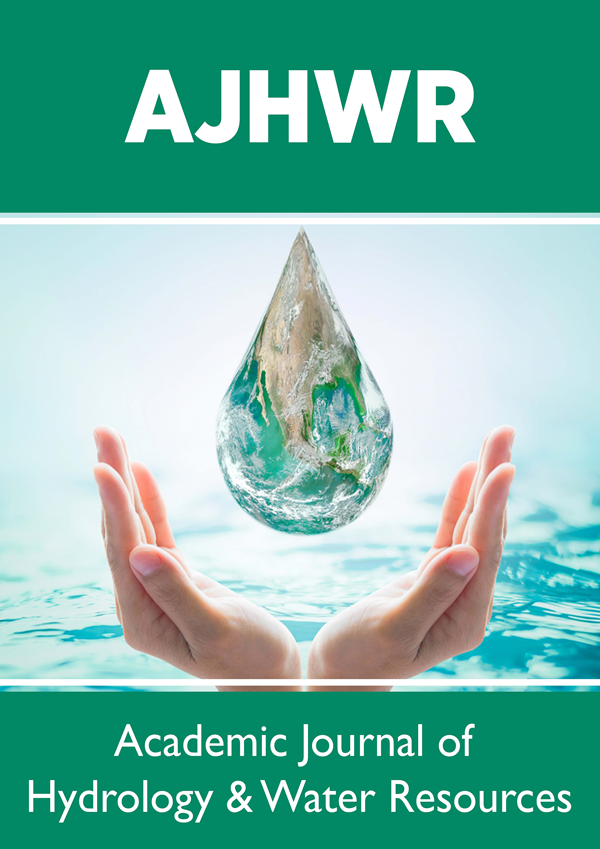Lupine Publishers Group
Lupine Publishers
Menu
Research Article 
Assessment of Water Supply and Hydraulic Losses of Wolayita Soddo Town Distribution System Volume 1 - Issue 1
Wubishet Alemu Enna1 and Tamene Mojira2*
- 1Water Mining and Energy Development Office, Wolayta Soddo, Ethiopia
- 2Civil and Irrigation Engineering Department, Ethiopian Sugar Industry Group, Ethiopia
Received: March 24, 2023 Published: April 17, 2023
Corresponding author: Tamene Mojira, Civil and Irrigation Engineering Department, Ethiopian Sugar Industry Group, Ethiopia
Abstract
Gaps in provision of adequate water supply to rapidly growing urban population in developing country are increasing dramatically. As a result, demand for additional water sources and infrastructure is growing. In this study, an attempt is made to evaluate both the water supply coverage and the water loss. This study envisioned to evaluate the town distribution coverage of the water supply and evaluating the total water loss at the town level. The water consumption aggregated from individual customer meter readings was used to evaluate the total water loss at town level. The total water loss derived from the water balance at town was compared using different performance indicators. Identifying pressure in distribution system was done by using WaterCADV8.0 software. Finally, a methodology was suggested to identify the loss and remedial actions to be taken by the water authority to reduce water loss were recommended. According to the analysis average per capita consumption was 24l/per/day, connection per family was 23% and the total water losses in the system were 25.24%. From the analysis, water demand and supply of the town was not balanced and the present water supply network services of the town is insufficient for all residents, some part of the system contains pressures above and below the maximum and minimum limit that were adapted in the distribution system and it needs adjustment. Also, the annual water loss of Town in terms of percentage was greater than the acceptable level which is 10% that cannot be removed. The infrastructure leakage index value was obtained to be 0.87 and less than an ideal value of 1 that indicates the real loss in the system close to unavoidable.
Keywords: Performance indicators; water supply; water losses; water audit software
Introduction
Clean water is essential for the survival and well-being of humankind. Based on millennium development goal targets, the urban areas of Africa will be accessed for improved water within 15 years from the year 2000. In a sustainable world, sufficient and safe water is made available to meet every person’s basic needs [1]. In many developing countries in Africa and Asia, urban water agencies have great difficulties providing proper water supply access and sanitation due to rapid urbanization and insufficient capacity and resources [2,3] Improving access to safe drinking water can result in tangible benefits to health. Every effort should be made to achieve drinking- water that is as safe as practicable. Water quality and the risk of waterborne diseases are critical public health concerns in many developing countries. Today, close to a billion people, most living in the developing world, do not have access to safe and adequate water. Water supply systems in urban areas are often unable to meet existing demands and are not available to everyone; rather, some consumers take disproportionate amounts of water, and the poor are the first victim to the problem [4]. Managing and reducing losses of water at all levels of a distribution system remains one of the major challenges facing many water utilities in most developing countries including Ethiopia.
Chala D [5] assessed the urban water supply coverage and hydraulic loss with the objective of evaluating the water supply coverage and hydraulic loss in distribution system by using different performance indicators. The researcher attempted to analyze hydraulic losses in order to quantify the amount of water as a loss from the total production. Currently the study town has faced water shortage due to the shortfall supply, increasing water demand and expansion of urbanization. The source of Soddo Town water supply system is boreholes (BH) and springs. The total volume of yield forms all boreholes was 73.5l/sec. The total volume water that obtained from springs is 42.6l/sec. The shapes of the reservoirs were circular with a flat roof, and they were constructed in concrete, and it has the treatment plant site. The reservoirs are provided with a valve chamber to accommodate both inlet and outlet valve requirements. A water meter was provided on the main line at the outlet of each reservoir to record the total flow of water to the distribution network.
The town water authority has great difficulty identifying where and how much water is lost and what are the main causes of the loss of water that this research is going to focus on. Therefore, assessing the water supply coverage and water loss using statistical and water audit methods in order to develop strategies for the future is more urgent than ever. These studies mainly focus on the status of water supply coverage and losses in study town. The technical performance measurement was evaluated by benchmarking the design document and current status of utility. Finally, the study had been identifying the existing information gap in water supply coverage, technical performance of the system and water loss in order to generate information to be used as a tool for making sound decisions and interventions for improvement of the water services.
Materials and Methods
Description of the Study Area
Wolaiyta Soddo town is situated at geographical coordinates are 6054’ latitude North and 37045’ longitude east. The relief of the town was mainly characterized by mountains, gorges and plain lands especially towards the southern direction. The altitude of the town ranges from 1800 - 2100 meters above sea level. Figure 1 shows the location map of the study area.
Climate
The condition of climate in a given environment has an effect on water supply and demand of water in the town. According to National Meteorological Agency of Ethiopia, Wolayita Soddo town mean minimum temperature is 7.5°C and means maximum temperature was 27.2°C. The mean annual rainfall has been reported to be 1212mm.
Data Source and Its Categories
a) Primary Data: data were accessed by direct observation in field, site surveying and through interviews. In the study interviews and a detailed site survey were conducted. Then observations were made on all critical points like water sources, service reservoirs in the distribution system in order to visually inspect leakages along the distribution network.
b) Secondary Data: This includes various published and unpublished documents, annual reports and design documents. They were collected at different levels and from different sources.
c) Water Supply Coverage Analysis: The water supply coverage of the study area was evaluated based on the average per capita consumption and level of connection per family. The average per capita consumption has been derived from the yearly consumption of each kebeles that has been aggregated from the individual domestic water meters.
d) Level of Connection per Family: Level of water connection was an important element in the evaluation of domestic water supply coverage. The following expression was used to calculate connection per family.

e) Average daily per capita consumption: The average daily per capita consumption of each kebeles was derived using the following expressions:

f) Technical Performance Analysis or Variability Study: Water consumption was one of the technical performance indicators of average daily water consumed by the customers and it was evaluated using equation (2). The other crucial technical*360 performance indicators were service coverage that water connected to water distribution system (WDS) and number of customers that indicates the percentage household connection in the town.
g) Water Losses Analysis: The water loss in the town water supply distribution system was evaluated using a top-down water balance method. Detail analysis of the water loss components was done using the AWWA free water audit software v5.0. The Validity Score for the AWWA method uses two metrics of importance for each of the 18 parameters. Those are an integer score from 1 to 10, and a weight for each parameter based on its importance. Each of the 18 parameters in the AWWA Version 5.0 software has a scoring system that provides the user with 11 choices.
Once grades were assigned to each input, the audit calculates a composite data validity score according to [6] equation 3 was used to calculate data validity score.

Where DVS is composite data validity score, Si denotes the user input score for input I and Wi denotes the weighting factor for input i
h) Determining the Water Balance Components: - A water balance search to identify all components of consumption and losses in a standardized format [7].
i) The Top-Down Annual Water Balance: The top-down method requires that bulk and customer water meters were installed and read for the period of at least one year. Unbilled authorized consumption (QUA) was determined by means of an appropriate estimate. First, all consumers were identified. These were households, municipal buildings, parks, water tankers or slum areas. The authorized consumption (QA) was calculated by adding QBA and QUA. The total water losses QL then were derived from QI - QA. Without specific data, Thornton recommends using 1.25% of the system input volume as an initial approach.
j) Assessing and quantifying apparent water losses: - Apparent losses that are non-physical losses caused by water meter inaccuracies, data handling errors and from any form of unauthorized consumption (water theft and illegal use) were quantified based on assumptions and estimates except water meter inaccuracies. According to the article, these assumptions were drawn up separately for each of the three main sources of apparent losses.

k) Non-revenue water: This volume was described as the water which does not provide any revenue to the Utility and is given by:

l) Calculation and Analysis of Important Performance Indicators: The establishment of a standardized water balance provides the water utility with reliable figures for the amount of real and apparent losses in their water supply system [8].
Operational Efficiency Performance Indicators (OPI)
a) Apparent Loss per Service Connection: -It was an important operational indicator in order to determine the volume of apparent losses per service connection in the distribution system. Also, it was very essential to compare and contrast among distribution system [9].
Since it was evaluated in the following formula: -

Where is Volume of apparent loss per day (m3 /day), Nc is Number of service connections.
b) Real Losses per Service Connection: -The importance of this performance indicator is to calculate competence of water supply system [10] It is expressed by: -

Where is the volume of real loss per day (m3 /day).
Technical Performance Indicators
a) Unavoidable Annual Real Losses (UARL): -Real water losses exist in every large water distribution network and can never be completely eliminated. A certain minimum amount of real losses remain, even in newly commissioned sections of a network. The unavoidable real losses, which represent the volume of real losses that could be reached at the current operating pressure if there were no financial or economic limitations.
The UARL draws on factors related to the length of the mains, the number of service connections and the location of customer meters and was valid for the average operating pressure. Accordingly, for this study Equation 8 Was used.

where UARL [l/day w.s.p.] is Unavoidable annual real losses, LN [km] is Network length (without service connection pipes), NC [ -] is Number of service connections, LP [km] is Length of private service pipes after the property line, L is after the property line up to the customer meter, PA [m] Average operating pressure.
b) Current Annual Real Losses (CARL): It was a useful parameter that distributed water intermittently. Since the number of days when the system was pressurized should be considered.it was determined in the following equation for this [11].

Where CARL [l/day w.s.p.] is Current annual real losses, QRL [m³/a] is Annual real water losses, Ndwsp [-] is Number of days when system is pressurized.
c) Infrastructure Leakage Index (ILI): It was an advanced and essential parameter that was recommended by (IWA, 2000). as a real loss performance indicator. It was also the ratio of current annual real loss (CARL) to unavoidable annual real loss (UARL) [12].

Demand Estimation
Domestic Water Demand Projection: the average daily domestic demand of the city is calculated by multiplying the number of people using a certain connection type with the per capital demand associated with that connection type. These are expressed as:

Where DDY is Domestic demand in year Y, PY is Population in Y year, HCY is Percentage of customers using house connection in Y year, YCY is Percentage of customers using yard connection in Y year, YSCY is Percentage of customers using yard shared connection in Y year, PTY is Percentage of customers using public tap connection in Y year, PCHC,Y is Per capital water demand of customers using house connection in year,PCYC,Y is Per capital water demand of customers using yard connection in Y year, PCYSC,Y is Per capital water demand of customers using yard shared connection, PCPT,Y is Per capital water demand of customers using public tap connection in Y year.
a) Sampling Water Meter: In the study area there were Different types and sizes of water meters were installed in the distribution system. Stratified random sampling technique was used to draw samples from the entire households in the town. The total sample size for this study was 122 households.
b) Customer metering inaccuracies was defined as the discrepancy between the amount of water actually consumed and the amount of water reportedly consumed due to under or over registering meters (Devan J., 2012). This type of error can be beneficial or detrimental to the utility, although typically meters tend to under-register more often than over-register. A general expression for estimating this metric is: -

Where M_error were apparent losses due to meter errors (m3/ year), V is billed metered consumption (m3/year), and A has average meter accuracy.
c) Average meter accuracy: The average meter accuracy for the system was determined according to (Devan J., 2012) using the 13 equations.

Where A is weighted average accuracy for the system, Xi Estimated average accuracy for each size of meter i, Ni Number of meters in service for each size of meterissss.
d) Analysis of hydraulic performance: The hydraulic modeling software Water CAD V8i” simulation was carried out for the purpose of pressure regime for customers demand, velocity, and head loss and overall, systematically studding and better understand network operation.
e) Data Entering: The input data needed to perform the analysis by the Water Cad Technique comprise the demand in the nodes, their elevations, pipes lengths, diameters, materials, reservoirs and their elevations, demand patterns, valves with different types and their control; pumps in the system, they can be modeled depending on their operating curves.
Results and Discussion
Level of Connection per Family: The average connection per family of the town was found to be 0.23 or 23 percent and it shows that more than four families were sharing one water connection or water tap. According to [13], the maximum level of domestic water supply connection per family was 1 or 100% (as best practice), which means one connection for one family. Therefore, the average level of connection per family of the town is lower and technically lower connection level means that the price of water is higher and that is burden to the public. Figure 2 implies that the level of connection per family in each kebeles of the study town.
a) Average Daily per Capita Consumption: the average daily per capita consumption of the town was found to be 24l/ person/day. According to [14], minimum quantity of 25liter/ person/day domestic water supply was categorized as basic level of service which was higher than the average domestic consumption of the town of Wolaitta Soddo. Out of the total 7 kebeles, 6 kebeles were getting water less than this basic service (25 l/per/d), whereas only one kebeles’ per capital consumption greater than the basic service. Also, the level of per capita consumption in some kebels were higher even though their level of connection per family was low or moderate as it indicated in Figures 3. The main reason for this gap was the existence of various institutions. Because of all this reason the per capita consumption of the town was low and needs amendment of the services.
b) Correlation between Water Consumption and Population: It is necessary to evaluate consumption with population. This has been evaluated using the correlation between the water consumption and number of populations. Plotting water consumption by number of populations graphically illustrates R-squared values for regression models (Figure 4). Figure 4 scatter plot for volume of water consumption and number of populations as shown in the above shows the coefficient of determination (R2) was 1, which indicates that the regression model accounts for 100% of water consumption was explained by population size.
c) Technical Performance Variability with Design Document: In order to measure the technical performance of water utility in terms of service coverage, water production and water consumption, metering level and non-revenue water (WSP-Africa, 2009) are discussed in the following parts.
d) Service Coverage: It was evaluated by taking the ratio of total number of beneficiaries from water utility and total number of populations in the town. According to the finding of this research, the percentage domestic water supply coverage of study area was 74.3 % which was less than the SWSSS Water Supply Coverage achievement planed in 2020 to be 100% as well as when compared to the MDG targets of urban Water Supply Coverage. Therefore it was lower than the expected one in the achievement plan and it indicated that the current water supply coverage was not sufficient regarding to the dramatic change of population in the town. The reason for decreasing was that there was not any expansion for water supply sources and components, whereas population growth and water demand were rapidly increasing (Figure 5).
e) Type of Water Consumption: From the information and data collected from Sodo Water Supply Service, in the study town the total number of Customer who has signed a contract with the office and utilizing the service have 13,621 in number and 13,488 active water service connections. Of these total numbers of customers 12,471 constitute private connection, 42 are public connection, 1,002 connections were commercial connections, and 106 were government and other institution.
f) System Water Losses: the system water losses in the study town to be higher than the recommended benchmarking target of 10%. According to the report of water audit software, the loss of study area was 25.24% in 2020. It was medium and this result has nearly similar with the actual losses (25.72%). According to [15], the system efficiency was good (acceptable) if above 75% of water produced reaches the consumer.
g) Water Loss Analysis: According to the detailed review of the M36 Manual on water audits and water loss, and the associated version 5.0 software; the total amount of water losses consisting real and apparent losses was 25.24% of the system input volume.
h) Real Loss: Regarding to this study the volume of water lost in cases of real loss was found to be 396,424 m3/year out of 1,717,893.92m3/year. In other word the total real loss from the supply distribution system was 24.94%. This analysis shows that there was high amount of real loss that have caused because of lack of well-organized or ordered infrastructure, existence of high pressure that led to breakage, leakage through hydraulic structures, existence of gaps in water meters accuracy.
i) Estimating Apparent Losses: since the apparent loss of study town was estimated as 7,505m3/year it covers 0.3% of the total annual water. Therefore, the value from the estimation, it understood that the apparent loss had significant value which had to be reduced parallel when it is compared to the real loss.
Operational Efficiency Performance Indicator (OPI)
a) Real Loss per Service Connection: - In the case of this study the real loss per connection of the town water utility was 79.73L/connection/day. However, the water utility of the study town regarding to the real loss per service connection was lower when it was compared with other town in Ethiopia like Axum which was 116.14 L/connection/day. The distribution was indicated that the distribution system of study town water utility was less susceptible for burst and leakage relating to another town.
b) Apparent Loss per Service Connection: Regarding this study the apparent loss of the study town was 1.5L/connection/day. This result shows that it was lower than that of Axum town which was 12.2L/connection/day in Deber Markos town which was 46.52 L/connection/day in and others. Therefore, apparent loss in the study area was negligible.
Technical Performance Indictors
Unavoidable Annual Real Losses (UARL)
According to the analysis UARL volume of study town water utility was 456.75m3/year. It has justified that the allowable volume of real losses from the system was approximated a volume of leakage that were not detected to repair during the year. Therefore, it is very crucial to determine the feasibility of real loss minimization.
Infrastructure Leakage Index (ILI)
In case of this study, the ILI was found that 0.87 for study area. According to [16] ILI values close to 1.0 mean that world-class leakage management was ensuring that annual Real Losses are close to the Unavoidable or Technical Minimum value at current operating pressures in practical terms. Therefore, in the study town the real loss was nearly unavoidable and operation in the system needs the expansion of existing infrastructure and additional water resource to meet the demand.
Available Pressure Heads/Network Simulation Results
From the results, the maximum and minimum pressures during low consumption (0.00 hrs) occur at nodes J-35 and J-1 are 90.63m and 14.53m of water column respectively whereas the maximum and minimum pressures during high consumption (8.00hrs) occur at nodes J-18 and J-1 are 88.92m and 14.73m of water column respectively. During minimum hour consumption, the residents get water at low pressure. This was due to the high elevation of the area which creates a low level of reliability of water users on the supply system. Figure 6 justifies the condition of pressure value during peak and low demand time.
Conclusions and Recommendations
Conclusions
As per this research the biggest problem observed is that there is a poor operation practice in the water utility. Due to the lack of proper maintenance practice, there are also some pipes and valves that are malfunctioning. Accordingly, the water distribution network faced pipe bursts and failures during low demand time and was exposed to large volume of water loss especially in high pressure zone areas. During high demand period mostly, residences found in dense population and high level of the town do not receive continuous water from the system. Thereby, water pressure in the distribution network observed that were not perfectly performing within the proposed maximum and minimum design criteria set by EFDRE, MOWIE. That means technically there is pressure related problem in distribution system that leads interruption of water supply of the community. Due to lack of operation and maintenance practice the water loss in the town goes up which makes the water demand and supply unbalanced. Its distribution and the average water supply coverage were evaluated based on the daily per capita consumption and level of connection and they are not satisfactory and far from the basic standard limit that were mentioned on [17]. The water loss analysis result revealed that; leakages, existence of poor maintenance services, burst of pipe, age of pipe, high pressure and customer meter errors are the main causes of the water loss in Wolayita Soddo town water supply service.
The physical observation and discussions with the stockholders in the town, besides to the analysis showed that, the town water supply system was dominated by aged pipes except the main line and newly formed kebeles. As 85% of the pipes are in the system that provides a service for the customers are too old and this was the main cause of water loss in the town. From the analysis of sample customer meters, significant variations were recorded depending on the location of the water meters of the customers. This indicates that the possibility of meters to have under recording is higher in meters located at higher elevation as result of low pressure. On the other hand, meters located at the higher consumption records are observed in meters located at lower elevation due to high pressure. According to [18] the system efficiency is not good (acceptable). Therefore, the study area water supply system regarding water losses is not acceptable. The prevention method and strategies to reduce water loss are explained in this study. However, from the quality of the available data and the complex nature of the water loss and leakage, this conclusion could only be taken as suggestive findings to be a base for further studies.
Recommendations
By using different methodology application approach to distribution systems result in better understanding and knowledge of minimizing uncontrolled flow rate, real losses and apparent losses. Also to satisfy as well as to balance the demand and supply of water in the town, expansion work was very crucial related to the urbanization development in the town is too high from time to time. Since the higher value of the loss has evaluated in conjunction with the amount of water, which is extremely low, the magnitude of the loss has expected to be higher, however, there would have been enough water supply in all areas. Therefore, attention should be given while additional water sources should be planned for the future that proper management of the existing infrastructure in general and the water network in particular is paramount. Introducing geographic information system (GIS) is timely as it may facilitate the updating of the networks and support to perform related spatial analysis. Using the recently prepared digital elevation model (DEM) to the town may support to divide the network into manageable smaller hydraulic zones or district meter areas. Attention must also be given for customer billing equity. Major differences are meter accuracy translates to unequal customer billing. A water system with a high unaccounted for water loss may have leakages or other distribution problems that must be addressed. Without accurate meters the degree of system problems cannot truly be known. [19] The accuracy of a utilities water meters should be a high priority and efforts made to maintain all meters at a high and uniform level of efficiency. In order to reduce the excessive pressure in the system by introducing a pressure reducing valve on the distribution network which can reduce the pressure below the acceptable range as per the design.
References
- WWAP (United Nations World Water Assessment Programme) (2015) The United Nations World Water Development Report 2015: Water for a Sustainable World. Paris, UNESCO.
- UN-HABITAT (2001) Cities in a Globalizing World, Global report on human settlements.
- Asmelash Z (2014) Assessing Water Supply Coverage and Water Losses from Distribution System for. Planning Water Loss Reduction Strategies Case Study on Axum town, North Ethiopia. Civil and Environmental Research 6(8): 82-87.
- Bereket B, Sharma SK (2006) Evaluation of water supply systems in selected urban poor areas of Addis. MSC Thesis. UNESCO-IHE Institute for Water Education, Delft, Netherlands pp. 135.
- Chala D (2011) An Assessment of Urban Water Supply and Hydraulic loss in the case of Ambo Town, Oromia Region. Addis Ababa University pp. 129.
- Kenneth R Friendman, James P (2009) Validity of Water Audit and Water Loss Evaluations for Florida: Conserve Florida Water Clearinghouse, Department of Environmental Engineering University of Florida Gainesville.
- Thornton J, Sturm R, Kunkel G (2008) Water Loss Control. McGraw-Hill. Google Scholar.
- Lambert A O, Brown TG, Takizawa M, Weimer D (1999). A Review of Performance Indicators for Real Losses from Water Supply Systems. Journal of Water Supply: Research and Technology – Aqua 48(6): 227-237.
- Sarah R (2006) Improvements and assessments of water auditing techniques. MSc Thesis. Texas A&M University 185: 72-98.
- Mutikanga H, sharma S, Vairavamoorthy K, Cabrera Z (2010) Using performance indicators as a water loss management tool in developing countries. Journal of Water Supply: Research and Technology - AQUA 59(9): 471-481
- (2000) (International Water Association). Water Losses, USA.
- Liemberger R, Ferly M (2004) Developing a non-revenue water reduction strategy: investigating and assessing water losses.
- Ministry of Water Resources of Ethiopia (2012) Cost Effective Design Guidelines for Urban Water Supply.
- Wallingford HR (2003) Handbook for the Assessment of Catchments Water Demand and Use.
- McKenzie RS, Lambert A (2004) Best practice performance indicators: a practical approach. Water21 8(2): 54-66.
- Liemberger R, Brothers K, Lambert AO, McKenzie R, Rizzo A, et al. (2007) Water Loss Performance Indicators. Proceedings of the IWA International Specialized Conference ‘Water Loss’, Bucharest, Romania.
- Devan J, Steven LB, Michael J (2012) Revenue recovery through meter replacement. American Water Works Association 104(4): E252-E259.
- Meron Amsalu, Tamene Mojira (2022) Drinking Water Quality Assessment from the Source to End User, the Case of Omo Kuraz Sugar Factory, Ethiopia. Hydrology 10(4): 75-85.
- WSP-Africa (2009) Water Operators Partnerships- Africa Utility Performance Assessment (Final Report 2009).

Top Editors
-

Mark E Smith
Bio chemistry
University of Texas Medical Branch, USA -

Lawrence A Presley
Department of Criminal Justice
Liberty University, USA -

Thomas W Miller
Department of Psychiatry
University of Kentucky, USA -

Gjumrakch Aliev
Department of Medicine
Gally International Biomedical Research & Consulting LLC, USA -

Christopher Bryant
Department of Urbanisation and Agricultural
Montreal university, USA -

Robert William Frare
Oral & Maxillofacial Pathology
New York University, USA -

Rudolph Modesto Navari
Gastroenterology and Hepatology
University of Alabama, UK -

Andrew Hague
Department of Medicine
Universities of Bradford, UK -

George Gregory Buttigieg
Maltese College of Obstetrics and Gynaecology, Europe -

Chen-Hsiung Yeh
Oncology
Circulogene Theranostics, England -
.png)
Emilio Bucio-Carrillo
Radiation Chemistry
National University of Mexico, USA -
.jpg)
Casey J Grenier
Analytical Chemistry
Wentworth Institute of Technology, USA -
Hany Atalah
Minimally Invasive Surgery
Mercer University school of Medicine, USA -

Abu-Hussein Muhamad
Pediatric Dentistry
University of Athens , Greece

The annual scholar awards from Lupine Publishers honor a selected number Read More...








